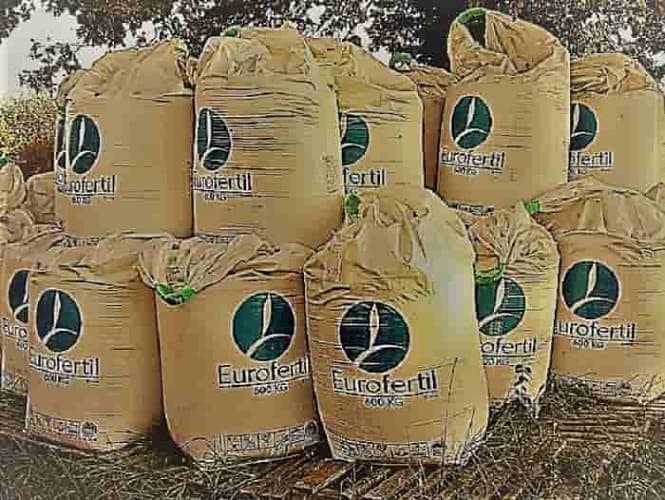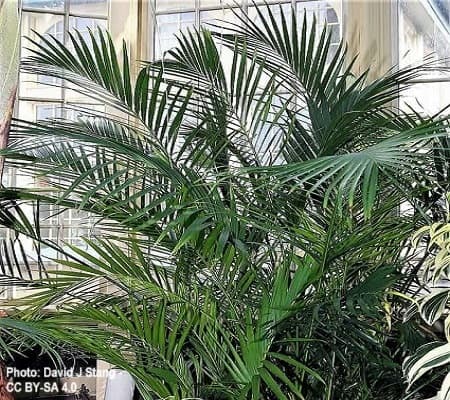- Home
- Caring For Palms
Care of a palm plant
Care of a palm plant is a process you'll get used to. It doesn't have to be overly hard for you to do! No, not intricate or tedious.
Our outline of simple steps for each palm care subject is for you now. We use these same basics to care for our own palm plants.
Use our plainly written steps to help your palm tree plant love its life! Learn how you can keep your palm healthy. Our palm tree care guides give you a hand-up For Outdoor Palms. As well as those Indoor Potted Palms you maintain inside your home.
We've found that knowing basic Sunlight & Watering Requirements are essentials to take care of. Their light needs & giving them water when they're thirsty can keep your own palm plant happy & healthy. We'll help you learn the basics of palm care here.
We have some of the top tips to help you out! Review These Steps:
Feeling overwhelmed by so many palm trees?
You're not alone. We Understand your headaches! At Mission: Palm Trees you'll find clear answers to questions & Step-By-Step Guidance, from real people. With solutions to help. No puzzling shoptalk. No tiring research. So it's easy & fun for you.
STEP 1: What Soil Concerns?
SEE STEP 2: Sunlight Needs>
STEP 3: How Much Water?
SEE STEP 4: How to Fertilize a Palm?
STEP 5: Should I Worry About Pruning?
SEE STEP 6: What May Bug My Palm?
STEP 7: What About a Potted Palm?
SEE STEP 8: Popular Palms With Extra Care
What's the Right Soil for Palm Plants?
Is there an exact correct soil type to keep your palm plant growing well?
There can be. The best thing for you to know is the nutritional sensitivities of your particular palm trees. Along with that, your area's particular soil conditions & yearly rainfall.
Nutritional lacking is most often noted from an imbalance or lack of needed minerals.
For instance, Florida is well-known for nutritionally poor soils. Which also receives lots of rain. Keep that in mind for your fertilization program.
Contrast that to California soils. Much of the state has less or even arid rainfall areas. Soils can range from organically rich to sandy deserts. Generally speaking, the soil quality is still an improvement for palm tree growth, more-so than Florida.
You should know your own local soil conditions. Some are more loamy, others have lots of clay content, and organically fortified soils have their own unique settings. All relate to your plan for fertilizing.
With a Soil Testing System, you can discover the exact type and contents of your local ground.
Palm Tree Light Requirements
Some palm trees come from arid areas, where there's lots of daily sun. Others may also come from those same desert type environments. Yet they may be smaller palms that grow beneath larger plants which provide them shade.
Many more palm trees have origins in rain forests. Or at least tropical areas with good rainy seasons. Either of these conditions could meet the care of a palm tree in your area, if you live in a similar climate.
All in all, what's most important to know is your own palm tree's needs. And it's best to know this before you begin Growing Your Palm Tree. So you'll choose the best placement.
Most do need a substantial amount of light during a day. Other palm trees absolutely need full sunlight throughout the day. Still others won't tolerate direct sunlight.

BEST WAY
The best way to figure out your own palm tree's light requirements is to consult the information you're given when Buying Your Palm Tree. Or the master gardener at that nursery.
If you don't have access to that information, then look up the species, or type of palm tree you have. See it's light needs. If you're potting a Palm For Indoor Placement, it's very important to know this.
Watering Palm Trees
Many palms like having moist soil conditions, yet not fully soggy.
They don't like the surrounding dirt to fully dry out. Depending on where you live, your rainy seasons or yearly rainfall, you might have to adapt the palm's watering schedule.
Your palm tree is now dependent on you and your climate conditions for water that it needs. Similar to its light requirements, your palm's original environment nurtured it, customizing its thirst.
 How Thirsty Will Your Palm Plant Be, So You Can Care for it Properly?
How Thirsty Will Your Palm Plant Be, So You Can Care for it Properly?Generally speaking, think about your care of a palm plant, there's no one-size-fits-all!
What you can do is know your own palm plant. Then weekly, size-up the dryness of its soil. You'll figure out how to water properly.
Palm Tree Fertilizer
FERTILIZING YOUR PALM
Fertilizing your palm tree makes sure it has the right nutrition. But does your own palm tree type actually need palm tree fertilizer?
It is individualized. But with Fertilizing A Palm, to a somewhat lesser degree. Just know the care of a palm plant for your own particular Species of Palm Tree.
Some palms need added minerals based on where they're growing. Others may need little supplementation. Some may survive without the need for any, but may see improved growth with palm fertilizer application.
FERTILIZE YOUR PALM CORRECTLY
Organic fertilizer is a good overall recommendation. Rather than a chemical formulation. Those with fish emulsion can be appropriate.
Package instructions advise you on wisest strength & how often to apply it. Where your palm is growing may mean adjusting the timing.
For instance indoor palms typically may not need fertilizer as often as palms growing outdoors.
Plus, if you have potted palms, those growing in containers, care with dosing is important.
Too much is literally overkill!!
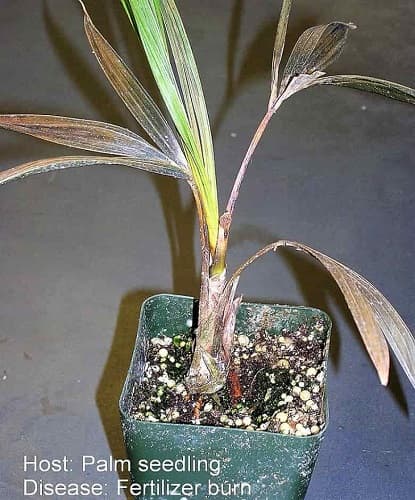
Essential Facts to Fertilizing Your Palm Tree
Palm Specialty fertilizers are best. But for any...
- Potassium to nitrogen percentage should be close to the same percentage.
- Include magnesium, at about 33% of potassium/nitrogen level.
HELP TO UNDERSTAND FERTILIZER LABELS
APPLYING FERTILIZER
Dry fertilizer grains shouldn't be placed against the palm trunk. That can hurt newly growing roots.
- Instead line some around irrigation emitters that are under the palm canopy.
- No irrigation system? Scatter correct amount under the canopy.
- Best type is with slow-release.
Liquid fertilizers can be okay, except for sandy soils.
- Inject into or soak areas of the root zone.
Formula to approximate palm tree dry fertilizer quantity application
- For each two-feet total height, use 1/2 lb. fertilizer.
- OR: (Total palm height/2) X 0.5 lb.
- But fully grown palm, more than 30' tall, maximum 15 pounds.
- Small Palms, under 8', 2-5 lbs. each use.
New Plantings: Gradually boost from 1/2 to two pounds, as growth increases.
Pruning in the Care of a Palm Plant
MAINTENANCE TO AVOID OVERGROWTH & HAVE BETTER HEALTH
Your palm may need some leaf trimming for better looks. It also helps it grow more healthy.
Yes, we're sounding like the cliched "broken record." But know your own care of a palm plant for best maintenance. As palms are all individuals. Some palms trees need pruning more than others. Some have a self-pruning system! Some palms...
- Spread out & overgrow wildly and/or widely.
- Are potted palms. Having specialized pruning needs.
- Need pruning after transplanting.
You'll want to remove dead fronds: those mostly all brown. Leave those partially or mostly green.
If you hire a pruning company, be sure they don't remove healthy fronds. It's sad to see a tall palm trunk with a few green fronds sprouting out from its top. As if it's a fountain!
But it's not, of course, it's a palm tree.
 Important idea for care of a palm plant is to prune cautiously.
Important idea for care of a palm plant is to prune cautiously.An To not damage beneficial parts of the plant. Those green leaf areas, which are the palm's natural food factories!
But With Browning Leaves There May Be A Problem>
Palm Tree Bugs
DO YOUR OWN PALM CHECK-UP!
Regularly Check Your Plant for Pests or Disease.
Schedule your exam to look for signs of pest attacks from palm tree bugs. Some palm trees are also susceptible to specific palm diseases. Quick action is the best preventive care of a palm plant to avoid uncontrolled outbreaks. We know you want to be sure you palm stays healthy.
Common palm tree bugs can attack. Particularly those vulnerable palm species. Pests like mealybugs, scale insects or spider mites. Any of these will damage palm fronds.
Another problem to check for are fungal diseases. Watch for rotting spots or wilting fronds.
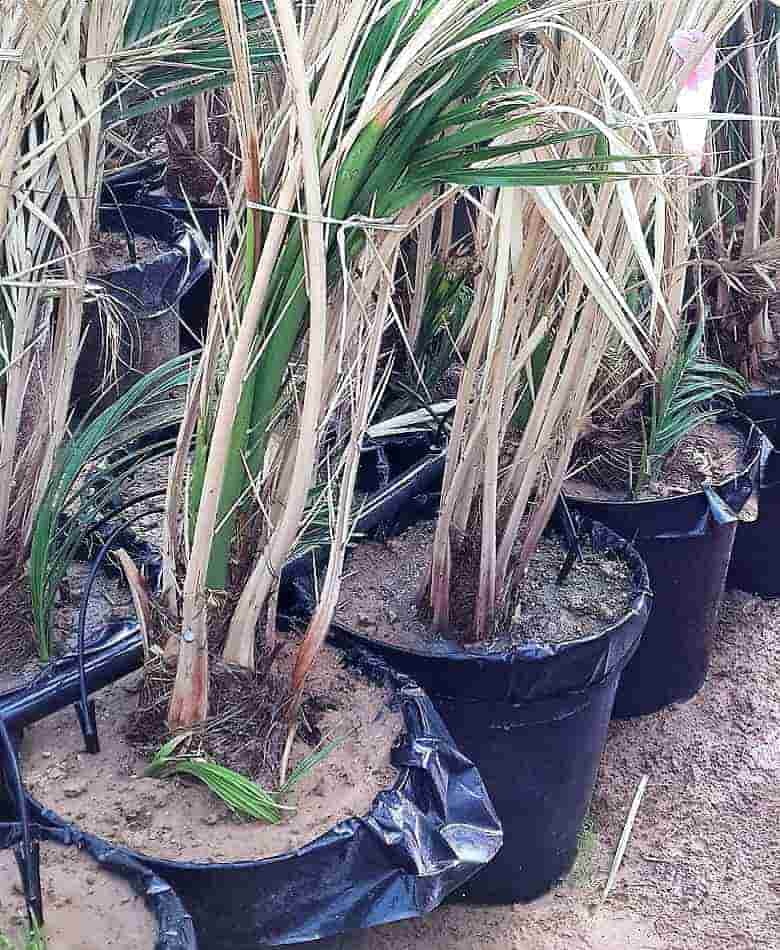 Plastic Lining Doesn't Allow Water Drainage
Plastic Lining Doesn't Allow Water DrainagePrime Condition Which Allowed Pink Rot
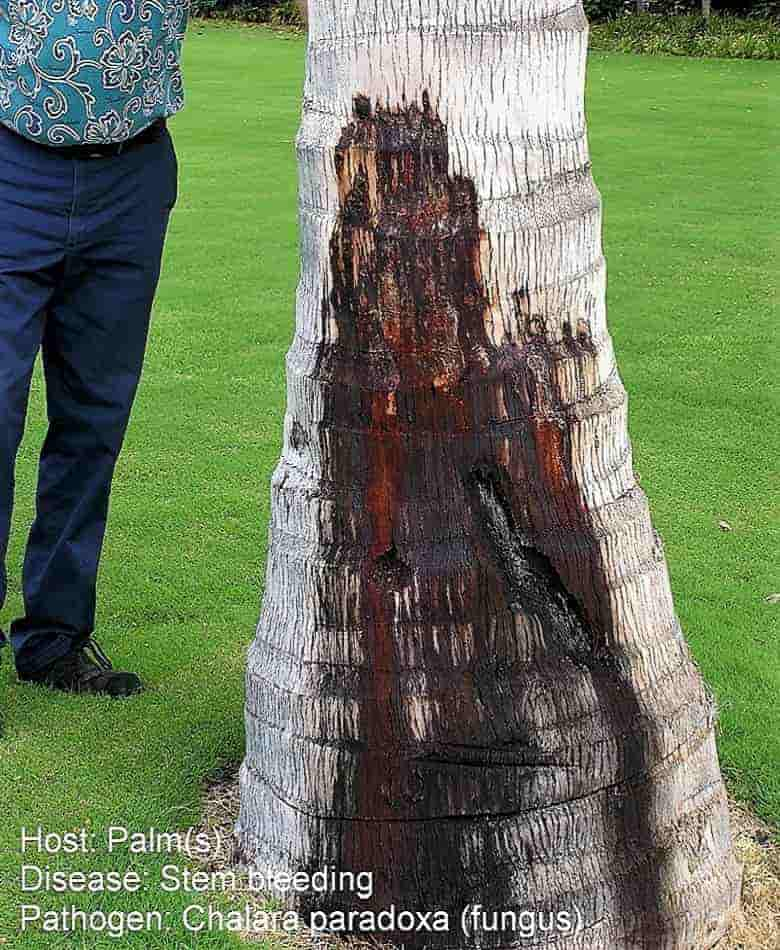 A Sad Attack by a Fungus on the Palm Trunk
A Sad Attack by a Fungus on the Palm Trunk Growing In Hawaii
If you get on top of any of these palm tree problems early on, they can usually be treated successfully. Methods include...
- Carefully pruning affected leaves and stalks.
- Applying some type of specified insecticide.
Care for Palm Trees
The care of a palm plant is really a huge subject. But right here, we're breaking it down into a few areas. Or just keep scrolling to view it all.
- If you're primarily concerned with indoor potted palms, there's Some Indoor Growing Tips for you.
- Best for avoiding worries of Your Indoor Palm Tree Dying.
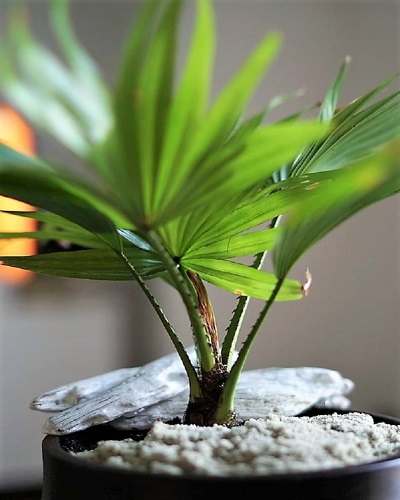 Care of a Palm Plant Growing in a Container
Care of a Palm Plant Growing in a ContainerHas Specific Needs
- Loving your Outdoor Landscape Plan for suitable palms?
- But need those Important Outdoor Palm Care Basics? We have that for you also.
- Are you concerned for the keys to successful care of a palm plant for certain species?
- We list a Few Popular Types.
- We also have tips for other Indoor Palms on our other container palm tree pages:
Palm Tree Care Outdoor
Our basic guide gives you knowledge for success in your care of a palm plant. Giving you general info to prepare you for a best outcome.
You can think about soil additions. Such as compost to provide nutrients. Or ground bark chips or coconut husks for use as mulch. To help retain ground moisture.
Our tips here help you figure out the best care of a palm planted outdoors, in general. There is only so much generalized tips can do in the care of a palm plant like yours. Because...
The best definitive palm tree care for your outdoor palm tree,
Is to know the individual needs of that palm.
Get the right palm into the right place.
We've said that many times, I know. But it's probably the most important point in the care of a palm plant!
Caring For Indoor Palm Plants
We know many of you like to have some Type of Potted Palm for various reasons. Many outdoor palm tree care tips also apply in general to potted palm trees. Yet there are specific details applying directly to potted palms.
More Care of a Palm Plant info...
SOIL
Most indoor palms do well with a mixture of approximately equal parts of these:
- Regular plant potting soil
- Clean sand
- Peat moss OR vermiculite.
Why is that a good palm potting combo?
- It keeps the soil oxygenated.
- It helps maintain a good temp for the roots.
- It makes easy pathways for water seepage, yet aids good drainage, while keeping soil damp.
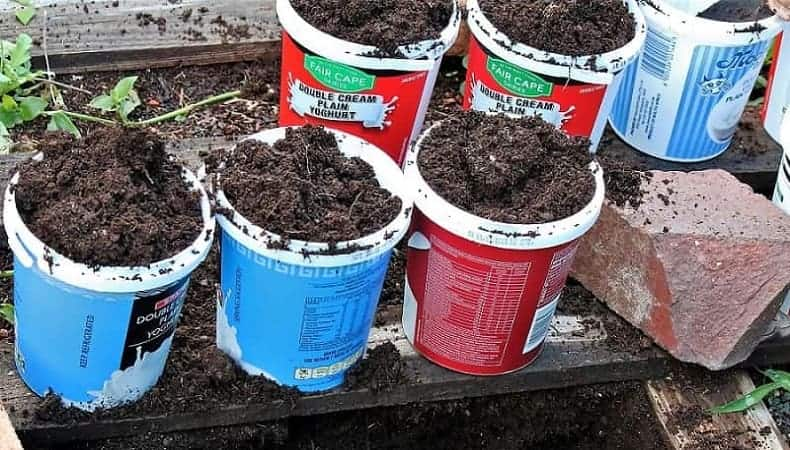 IDEA: Create Your Own Potting Concoction. Be Green & Store it by Reusing Clean Containers
IDEA: Create Your Own Potting Concoction. Be Green & Store it by Reusing Clean ContainersLIGHT REQUIREMENTS FOR INDOOR PALM PLANTS
Many potted palms light bright, yet indirect sunlight. Generally they need about 5-6 hours worth each day.
Be sure the sun isn't so strong through windows, that it completely dries out palm leaves. Withering them.
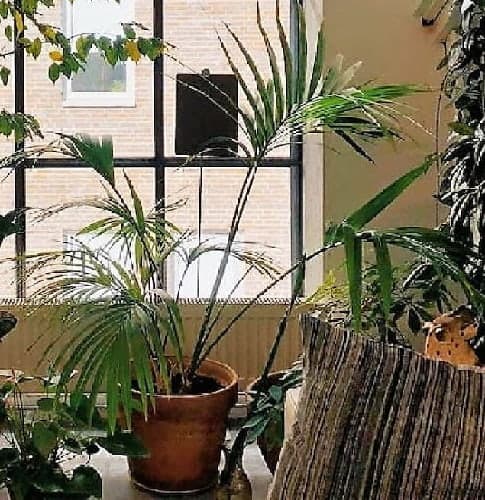 Will This Window's Light Give That Palm Enough Light?
Will This Window's Light Give That Palm Enough Light?What Do You Think?
FERTILIZER FOR A POTTED PALM
If your palm is contained in a pot, its fertilizer timing needs become more frequent. As it more quickly uses up the minerals and other components for its healthy growth.
But it's a balance. Don't overdo the amount you apply, to avoid burn. It's a dangerous thing! For instance, Take a Look at This Example!
PROBLEMS
Houseplants can be prone to problems because of the unnatural growing conditions they're enduring. For your care of a palm plant placed indoors, check regularly to quickly head off problems. Look for tell-tale signs of pests or disease.
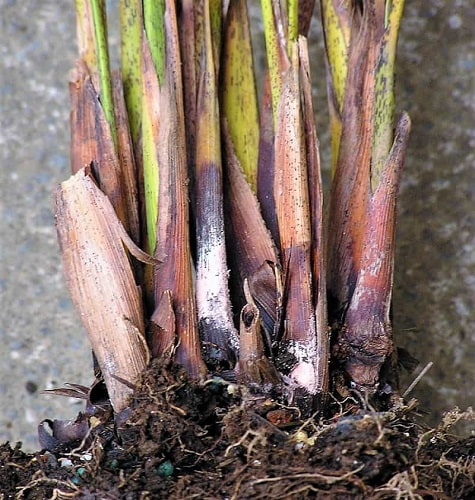 Areca Palm Removed From a Pot to Find the Problem
Areca Palm Removed From a Pot to Find the ProblemIt's Pink Rot Caused by the Ganoderma Fungus
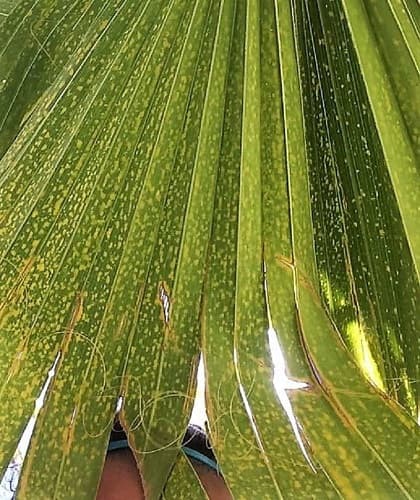 Palm Fronds
Palm FrondsShowing Potassium Deficiency Symptoms
A Mosaic Appearance of Chlorotic Flecking
Provide the Right Amount of Light and Water
With the care of a palm plant, knowing the right amount of light & water for your own plant species' needs is important. The Original Areas of That Palm may be in variable environments.
So the care for one palm plant can be different from another. The best way is always to know the exact needs for your type of palm.
See what we mean, with these palm tree examples that follow...
Majesty Palm Care
Ravenea rivularis (meaning "of the rivers") is often grown as a potted plant in containers. If you working out a care of a palm plant for a Majesty, be aware of its needs. Which are fairly particular!
Its native origins are in Madagascar. Growing at riversides, and in swamps. Can you tell it loves the water?! Making Majesty palm care demanding.
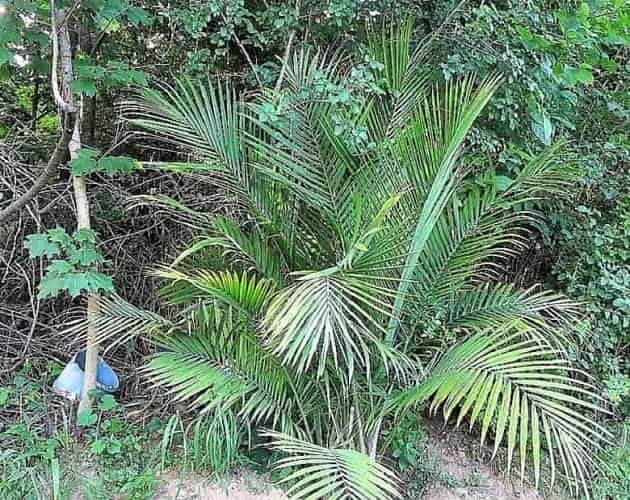 Majesty Palm Houseplant Became Too Large for Inside a Home
Majesty Palm Houseplant Became Too Large for Inside a HomeHere It's Being Transplanted to the Outdoors!
WHAT ELSE FOR THIS MAJESTY?
- It loves mucky soil, regular watering. If the soil's top 1" seems dry, give it a good drink!
- Its high humidity needs may be problematic for indoor planting care. Wintertime indoor heating adds to air dryness. Regular frond misting may help.
- It likes sunlight. Gotta give it lots of that, too!
Chinese Fan Palm Care
Livistona chinensis makes a nice indoor palm specimen plant. Care of a palm plant of this species, though, is best for areas with the room for it.
It grows at a medium rate of speed, so if you intend it for a small space, it may quickly overwhelm that plan!
WHAT ELSE FOR THE CHINESE FAN?
- It's best with humus added soil.
- Indoors it needs lots of room, plus lots of light. Get it by a large window!
WATER NEEDS
- Not overly thirsty, it can dry out with little problem. As long as you get to watering soon!
- Water regularly for best results, though.
- Be sure the soil drains well also.
Cat Palm Care
Chamaedorea cataractarum is loved as an indoor potted palm tree because its maximum height is 5'. But for success, takes lots of care & work.
Its nickname comes from a shortened form of the scientific epithet. Which actually refers to cataracts that are waterfalls. Because it originated along southern Mexican rainforest rivers & streams.
For the care of a palm plant called the Cat Palm, can you now guess it needs lots of water?! And doesn't mind having wet "feet"!
WHAT ELSE FOR CAT PALM CARE NEEDS?
Outdoors:
- Good for Zones 10-11. Possible for 9's circumstances.
- As a clumping plant, it can spread to 10' wide. You might want to contain that by pruning.
Indoors:
- Wants decently bright light, get it by a good window.
- Inside beware of mealybugs & mites.
- Can have issues with Gliocladium Blight caused by fungus.
Care of a Palm Plant Takeaways
We hope you found our information on the care of a palm plant valuable for what you needed.
If there's anything unclear, of that we didn't cover, we want to help you out. So please tell us what you need, by Letting Us Know Here>
